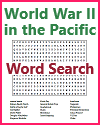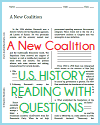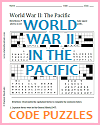Japan, Pearl Harbor, and the War |
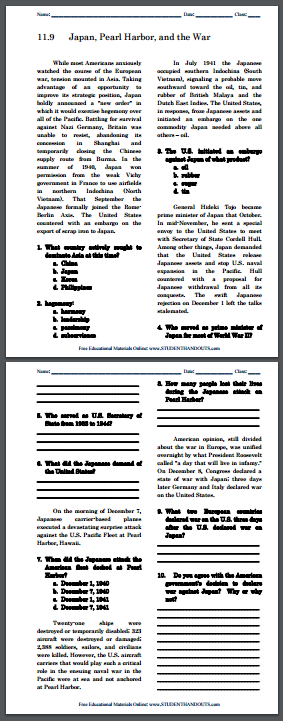 While most Americans anxiously watched the
course of the European war, tension mounted in Asia. Taking
advantage of an opportunity to improve its strategic position,
Japan boldly announced a "new order" in which it would exercise
hegemony over all of the Pacific. Battling for survival against
Nazi Germany, Britain was unable to resist, abandoning its
concession in Shanghai and temporarily closing the Chinese
supply route from Burma. In the summer of 1940, Japan won
permission from the weak Vichy government in France to use
airfields in northern Indochina (North Vietnam). That September
the Japanese formally joined the Rome-Berlin Axis. The United
States countered with an embargo on the export of scrap iron to
Japan. While most Americans anxiously watched the
course of the European war, tension mounted in Asia. Taking
advantage of an opportunity to improve its strategic position,
Japan boldly announced a "new order" in which it would exercise
hegemony over all of the Pacific. Battling for survival against
Nazi Germany, Britain was unable to resist, abandoning its
concession in Shanghai and temporarily closing the Chinese
supply route from Burma. In the summer of 1940, Japan won
permission from the weak Vichy government in France to use
airfields in northern Indochina (North Vietnam). That September
the Japanese formally joined the Rome-Berlin Axis. The United
States countered with an embargo on the export of scrap iron to
Japan.1. What country actively sought to dominate Asia at this time? a. China b. Japan c. Korea d. Philippines 2. hegemony: a. harmony b. leadership c. parsimony d. subservience In July 1941 the Japanese occupied southern Indochina (South Vietnam), signaling a probable move southward toward the oil, tin, and rubber of British Malaya and the Dutch East Indies. The United States, in response, froze Japanese assets and initiated an embargo on the one commodity Japan needed above all others – oil. 3. The U.S. initiated an embargo against Japan of what product? a. oil b. rubber c. sugar d. tin General Hideki Tojo became prime minister of Japan that October. In mid-November, he sent a special envoy to the United States to meet with Secretary of State Cordell Hull. Among other things, Japan demanded that the United States release Japanese assets and stop U.S. naval expansion in the Pacific. Hull countered with a proposal for Japanese withdrawal from all its conquests. The swift Japanese rejection on December 1 left the talks stalemated. 4. Who served as prime minister of Japan for most of World War II? 5. Who served as U.S. Secretary of State from 1933 to 1944? 6. What did the Japanese demand of the United States? On the morning of December 7, Japanese carrier-based planes executed a devastating surprise attack against the U.S. Pacific Fleet at Pearl Harbor, Hawaii. 7. When did the Japanese attack the American fleet docked at Pearl Harbor? a. December 1, 1940 b. December 7, 1940 c. December 1, 1941 d. December 7, 1941 Twenty-one ships were destroyed or temporarily disabled; 323 aircraft were destroyed or damaged; 2,388 soldiers, sailors, and civilians were killed. However, the U.S. aircraft carriers that would play such a critical role in the ensuing naval war in the Pacific were at sea and not anchored at Pearl Harbor. 8. How many people lost their lives during the Japanese attack on Pearl Harbor? American opinion, still divided about the war in Europe, was unified overnight by what President Roosevelt called "a day that will live in infamy." On December 8, Congress declared a state of war with Japan; three days later Germany and Italy declared war on the United States. 9. What two European countries declared war on the U.S. three days after the U.S. declared war on Japan? 10. Do you agree with the American government’s decision to declare war against Japan? Why or why not? |
Answer Key: 1. B - Japan; 2. B - leadership; 3. A - oil; 4. Hideki Tojo; 5. Cordell Hull; 6. United States release Japanese assets and stop U.S. naval
expansion in the Pacific; 7. D - December 7, 1941; 8. 2,388; 9. Germany and Italy; 10. Answers will vary. Click here to print this worksheet. |
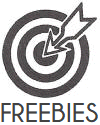 |
|---|



